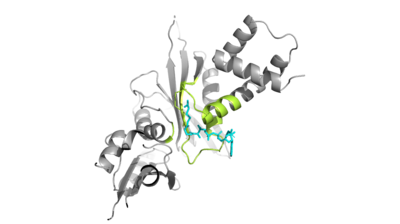User:Caitlin Marie Gaich/Sandbox1
From Proteopedia
(Difference between revisions)
| Line 13: | Line 13: | ||
The HAT1 and HAT2 interface is stabilized by hydrogen bonds, <scene name='81/811717/Salt_bridges/1'>salt bridges</scene>, and hydrophobic interactions. Most of these interactions are located in <scene name='81/811717/Lp1/2'>LP1</scene> of the HAT1 domain, which forms a well-ordered helix. This LP1 helix is thought to be important for the heterodimer formation as the deletion of LP1 abolished the interaction between HAT1 and HAT2. This suggests that there may be another protein involved such as the N terminus tail of H4 acting as a linker protein interacting with the complex interface. The three major areas where hydrogen bonds are present aids in this complex formation. The side chain atoms of <scene name='81/811717/Tyr199_asp308_ala202/5'>Tyr199 and Asp308</scene> with the main chain nitrogen of Ala202 in HAT1. The side chain of <scene name='81/811717/Lys211phe205_and_leu288arg282/7'>Lys211 and Arg282</scene> makes hydrogen bonds with Leu288 and Phe205 respectively. The last area of hydrogen bonds between HAT1 and HAT is found between <scene name='81/811717/Serine_hydrogen_bonds/3'>Ser263 and Asp 206</scene>. The <scene name='81/811717/Hydrophobic_core/2'>hydrophobic core</scene> at the interface of the complex appears to be critical for the complex formation. This core consists of aromatic amino acids from HAT1 and leucine amino acids from HAT2, however it does not form any obvious ring stacking. | The HAT1 and HAT2 interface is stabilized by hydrogen bonds, <scene name='81/811717/Salt_bridges/1'>salt bridges</scene>, and hydrophobic interactions. Most of these interactions are located in <scene name='81/811717/Lp1/2'>LP1</scene> of the HAT1 domain, which forms a well-ordered helix. This LP1 helix is thought to be important for the heterodimer formation as the deletion of LP1 abolished the interaction between HAT1 and HAT2. This suggests that there may be another protein involved such as the N terminus tail of H4 acting as a linker protein interacting with the complex interface. The three major areas where hydrogen bonds are present aids in this complex formation. The side chain atoms of <scene name='81/811717/Tyr199_asp308_ala202/5'>Tyr199 and Asp308</scene> with the main chain nitrogen of Ala202 in HAT1. The side chain of <scene name='81/811717/Lys211phe205_and_leu288arg282/7'>Lys211 and Arg282</scene> makes hydrogen bonds with Leu288 and Phe205 respectively. The last area of hydrogen bonds between HAT1 and HAT is found between <scene name='81/811717/Serine_hydrogen_bonds/3'>Ser263 and Asp 206</scene>. The <scene name='81/811717/Hydrophobic_core/2'>hydrophobic core</scene> at the interface of the complex appears to be critical for the complex formation. This core consists of aromatic amino acids from HAT1 and leucine amino acids from HAT2, however it does not form any obvious ring stacking. | ||
| - | Once the complex has formed, histone 4 and AcetylCoA can begin to interact. | + | Once the complex has formed, histone 4 and AcetylCoA can begin to interact. The N-terminal segment of H4 that binds with HAT1/HAT2 can be divided into three different regions. |
Revision as of 16:02, 11 April 2019
Histone Acetyltransferase HAT1/HAT2 Complex, Saccharomyces cerevisiae
| |||||||||||

